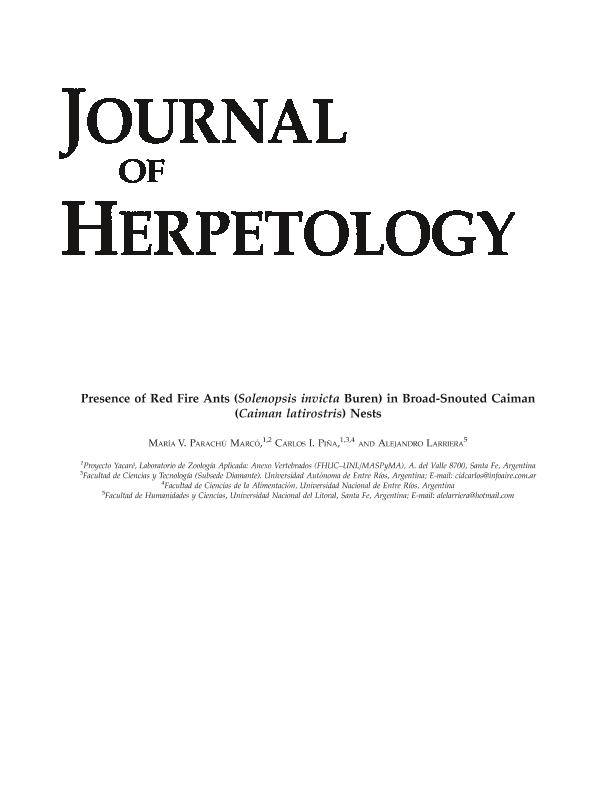Artículo
Presence of red fire ants (Solenopsis invicta Buren) in broad-snouted Caiman (Caiman latirostris) nests
Fecha de publicación:
06/2012
Editorial:
Society for the Study of Amphibians and Reptiles
Revista:
Journal of Herpetology
ISSN:
0022-1511
Idioma:
Inglés
Tipo de recurso:
Artículo publicado
Clasificación temática:
Resumen
The presence of Solenopsis invicta in Caiman latirostris nests is suspected to be a possible cause of death in caiman hatchlings, but this has not been documented within the native distribution of this ant. In crocodilian ranching programs, wild eggs are collected from the field, and delays between collection and transportation to incubators are usually minimized in the hope of maximizing embryo survival. We analyzed nests harvested during five consecutive nesting seasons of C. latirostris to determine the phenology of S. invicta colonization of caiman nests. The percentages of colonized caiman nests for each season were calculated. Densities of S. invicta mounds built on bare ground were assessed to determine potential relationships between density and the proportion of caiman nests colonized by the end of nesting season. We also evaluated whether S. invicta preferred certain habitats to establish their mounds. We found no relationship between S. invicta mound densities and the percentage of C. latirostris nests with Red Fire Ants. The presence of S. invicta mounds among years was similar between different habitats at the beginning of each season. We found that S. invicta can colonize C. latirostris nests during the breeding period and that colonization of nests is higher than 50 in seasons where rainfall was 200 mm at the beginning of the season (December and January). In contrast, during years in which rainfall was below 200 mm, caiman nest colonization was reduced. Copyright © 2012 Society for the Study of Amphibians and Reptiles.
Archivos asociados
Licencia
Identificadores
Colecciones
Articulos(CICYTTP)
Articulos de CENTRO DE INV.CIENT.Y TRANSFERENCIA TEC A LA PROD
Articulos de CENTRO DE INV.CIENT.Y TRANSFERENCIA TEC A LA PROD
Citación
Parachu Marco, Maria Virginia; Piña, Carlos Ignacio; Larriera, Alejandro; Presence of red fire ants (Solenopsis invicta Buren) in broad-snouted Caiman (Caiman latirostris) nests; Society for the Study of Amphibians and Reptiles; Journal of Herpetology; 46; 2; 6-2012; 228-232
Compartir
Altmétricas




